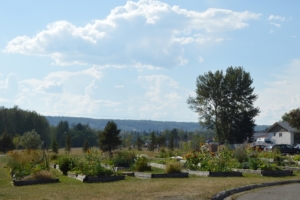There is nothing more beautiful than a cordwood wall. Add the benefits of being green, its low material cost, its simple construction method, and it becomes an even more attractive building option.
 The warmth of the color of the wood, and exposed round ends, gives special beauty to the cordwood wall
The warmth of the color of the wood, and exposed round ends, gives special beauty to the cordwood wall
Cordwood construction is sometimes also called “stackwood construction.” A cordwood building consists of short, round pieces of wood (think firewood) held together with mortar.
Several years ago, my family was involved in starting a Community Garden in our city. We wanted to grow our own vegetables and be part of something special. We got permission to use a vacant lot, and we got a very small grant to purchase supplies. In return we would build garden beds, build a shed, and offer educational programs to the local schools and the community at large. The grant was just enough to purchase the wood for the garden boxes, and we got free compost.
How to build the shed?
Luckily, there was no shortage of logs! And no shortage of willing hands! We decided to build a cordwood shed, with a vegetated roof. As an Architect, I donated my time to design and draw the drawings for the building permit and the design review process. When we got approval from the Design Review Board, many local businesses and tradespeople stepped up to donate engineering consultation, labor and materials.
The Construction
 In line with our goals to educate, a plaque by the shed, tells the story of how we started the garden and built the shed.
In line with our goals to educate, a plaque by the shed, tells the story of how we started the garden and built the shed. Each person was responsible to build their own bed, but we all helped those who needed it.
Each person was responsible to build their own bed, but we all helped those who needed it.
We hosted a 3 day workshop, lead by Rob and Jaki Roy of Earthwood in New York State, which marked the beginning of the cordwood wall construction.
There are a lot of great reasons to build a cordwood building, but it is not without difficulties. This is what we learned:
- If you use the logs before they are fully seasoned and dry, they will shrink during construction. This makes it easy for vandals to knock out logs, and it is hard to repair.
- Even with many willing hands, it is a very slow process.
- It is important to get the mortar mix right. We used 9 parts sand, 3 parts soaked sawdust, 3 parts type S lime and 2 parts Portland cement. If it is too wet, or too dry, or has the incorrect proportions, it is harder to use.
- It was a lot of fun to work with a team and be part of something.
Learn more about this project in our Portfolio: Community Garden, Giving Back with Pro Bono Architectural Services

